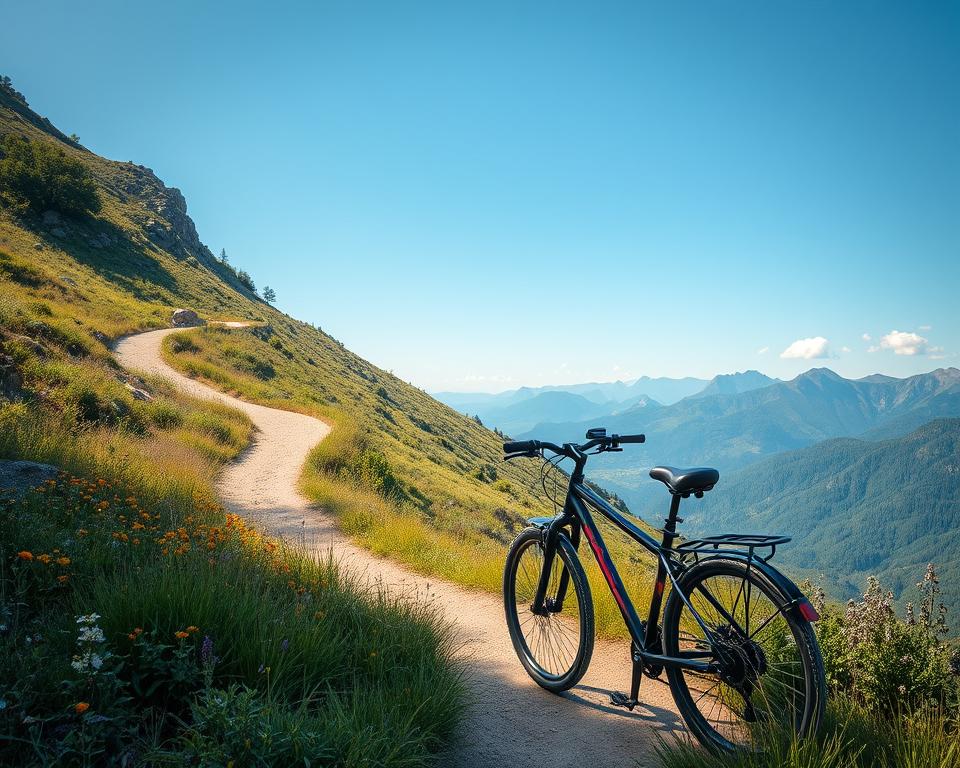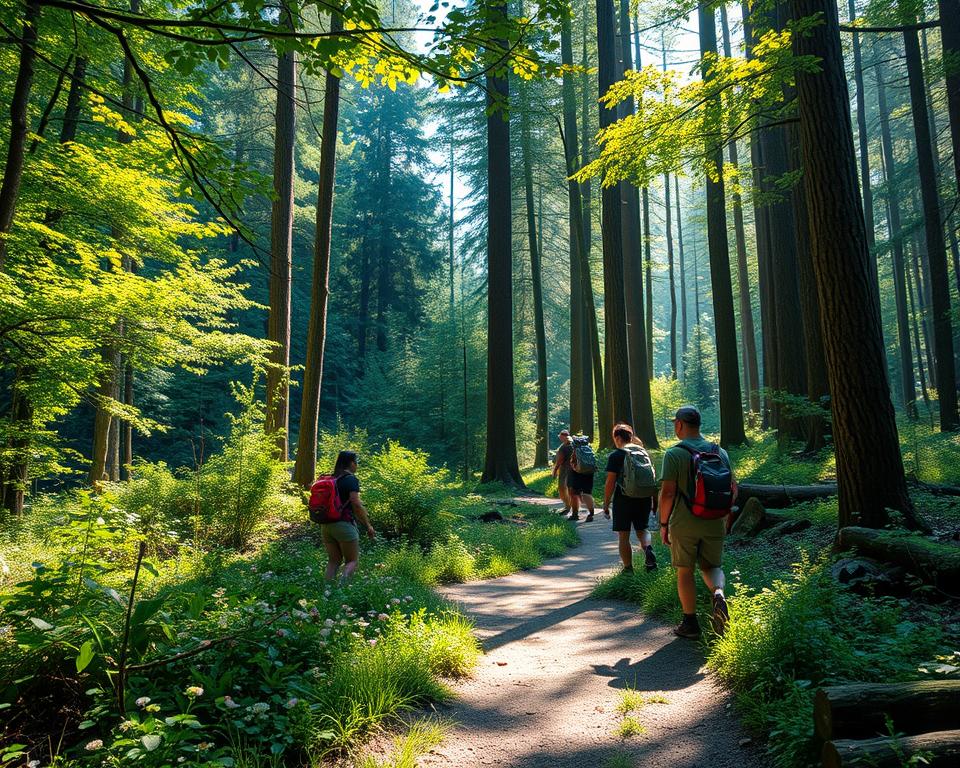Planning a sustainable hike is vital for nature and our well-being. Eco-conscious trekking lets us enjoy nature with minimal environmental impact. This practice helps us feel closer to nature and live more responsibly. As of 2017, nearly 45 million people went hiking in the U.S., stressing the need for eco-friendly hiking habits.
Time spent outdoors can lower stress, enhance creativity, and better our mental health. Committing to eco-friendly hiking ensures these places stay beautiful for others. For example, plants at high altitudes need years to grow back if damaged. That’s why it’s key to follow trails and Leave No Trace principles. These include disposing of waste correctly, limiting campfire effects, and not disturbing wildlife.
By adopting eco-conscious habits, we aim to preserve our natural world. Utilizing services like King County’s Trailhead Direct lessens our carbon footprint. It shows dedication to less environmentally harmful hiking. Groups like Mountains to Sound Greenway Trust and Washington Trails Association work to balance human and wildlife needs. Their efforts prove careful planning and considerate actions can help us coexist with nature.
The Benefits of Eco-Friendly Hiking
Going green while hiking is good for both the environment and us. Being mindful keeps our nature beautiful for the future. Let’s explore some top benefits.
Physical and Mental Health Benefits
One main health perk of hiking is better physical fitness. Climbing and walking on trails give us a solid workout. Also, being outside lowers stress and makes us more creative. This mix enhances how well we feel outdoors.
Environmental Preservation
Hiking the green way stresses on caring for our ecosystems. By sticking to trails and treating wildlife well, we lessen our environmental footprint. These acts support looking after our planet. So, using things like reusable water bottles protects nature bit by bit.
Enhanced Connection with Nature
Eco-friendly hiking helps us bond deeply with nature. Sustainable habits on trails increase our awareness of nature’s balance. This awareness grows, encouraging eco-friendly choices in daily life. The beauty and peace of nature, paired with caring for it, deepens our appreciation for our surroundings.
If we hike with the environment in mind, we enjoy it more and help our earth. Let’s all hike responsibly and cherish our time outdoors responsibly.
Leave No Trace Principles: Key to Minimal Impact
Everyone who loves trails should know the Leave No Trace principles. They are designed to reduce our impact and keep nature beautiful. Understanding these principles is key for eco-friendly outdoor activities.
Plan and Prepare
Being well-prepared is vital for not harming nature. Planning helps avoid damage to the environment. For instance, camp far from water to protect natural areas. Also, bring a stove to reduce the need for fires.
Stick to Designated Trails
It’s important to stay on marked trails. This protects wildlife and their homes. It also keeps the ecosystem safe while we enjoy nature’s beauty.
Dispose of Waste Properly
The rule “Pack it in, Pack it out” keeps nature clean. Dispose of all waste rightly. Bury human waste deep and far from water and trails. This keeps animals and water sources safe.
Minimize Campfire Impact
Campfires can harm nature. It’s better to use a stove. If you must have a fire, do it in established areas. This helps prevent forest fires and keeps the environment undamaged.
Respect Wildlife
Keep a safe distance from animals. Never feed them. Store food securely. This protects their health and ours. It keeps their behavior natural.
By following Leave No Trace, we protect nature. These practices help us enjoy clean, beautiful trails. They ensure a great experience for all future nature lovers.
How to plan an eco-friendly hike
Planning an eco-friendly hike means you aim to leave no trace behind. It’s about reducing your environmental impact while enjoying nature. About 9 out of 10 successful hikes start with good planning. Let’s explore key steps for sustainable excursion planning:
- Research the Trail: Find guidebooks at local spots or use apps like All Trails for maps and trail info. Pick one that suits your fitness level.
- Plan According to the Season: Make sure the weather and season are right for your hike. It affects safety and trail difficulty.
- Gather Necessary Gear: Pack sun protection and the right clothes. Opt for eco-friendly gear for your green journey.
- Prepare Sufficient Supplies: Bring enough water and snacks. Using a reusable water bottle is a smart move. Also, pack a first aid kit for safety.
- Inform Others: Always tell someone about your hiking plan. If you’re in a group, keep it under 10 to lessen the impact on nature.
- Develop Basic Navigation Skills: Knowing how to read a map is crucial for navigating through different terrains.
- Start Small: First, try local and easy trails. It’s a great way to prepare for more difficult hikes.
By sticking to these steps for sustainable excursion planning, your eco-hike preparation will be solid and kind to the planet. This way, you’re not just having fun. You’re also helping to keep the trails beautiful for everyone after you.
Choosing Sustainable Hiking Gear
Going on a hike with earth-friendly gear is key to reducing harm to the environment. Picking gear from ethical brands can greatly help nature and the outdoor industry. Let’s look at what to keep in mind when choosing sustainable hiking gear.
Selecting Ethical Brands
Finding ethical brands is step one for sustainable gear. Companies like Merrell and Patagonia stand out for their green practices. Look for seals of approval like Bluesign or Fair Wear, which mean the items are made with care for the planet and people.
When we support green brands, we push the whole outdoor world to do better. Buying ethical gear improves your experience and supports a move towards caring more for our planet.
Durability and Recycling
How long gear lasts is super important for the planet. Strong, long-lasting items don’t need to be replaced as often, creating less trash. Osprey, for example, offers tough products that can be recycled, helping to cut down on waste.
Choosing gear that’s both durable and eco-conscious means it’ll last and is made thoughtfully. Take the Allbirds Trail Runners at $140, which are made with nature in mind. Or BioLite’s CampStove 2+ at $149.95, which uses less fuel and is more efficient.
Opting for green outdoor gear is more than just buying stuff—it’s about a way of life that honors our environment. By making wise gear choices, we aid in creating a green and thriving world for hiking.
Preparation Tips for a Sustainable Hike
Getting ready for a hike is key to having fun and being green. Here are some important steps to get ready for the trail.
Research the Trail
Start by learning about the hiking trail you’ve picked. Look into how hard it is, its rules, and special features. This prep helps you know what’s coming and tackle any challenges.
Sticking to marked paths keeps you safe and helps the environment. It stops soil erosion and keeps plants safe.
Stay Hydrated with Reusable Bottles
Staying hydrated is crucial on hikes. Reusable bottles cut down on single-use plastic waste. Check out durable, eco-friendly bottles from brands like Hydro Flask and Nalgene.
Refill at local spots to help the community and lower your eco-footprint.
Weather-Appropriate Clothing
Picking the right clothes for hiking means dressing for the weather. Layers let you adjust to temperature changes. Go for sustainable brands like Patagonia or The North Face for long-lasting gear.
Dressing right reduces injury risk and makes the hike more comfortable. This also supports eco-friendly hiking.
Planning your hike well and choosing sustainable actions helps protect nature. This way, we enjoy the outdoors and keep it beautiful for everyone.
Transportation and Trail Etiquette
Being eco-friendly and polite on trails is key to keeping them great for everyone. By handling pets properly and behaving well, we lessen our marks on nature. This helps everyone enjoy the trails in peace.

Carpooling and Public Transport
Using car shares or buses can reduce pollution. It also eases the traffic and lack of parking at trail starts. When we ride together, we help the planet and make things better for everyone.
Respect Fellow Hikers
It’s important to follow trail manners. Let others go first, especially bikers and horse riders, and always give the right of way to those going uphill. Keeping quiet makes the outdoors more enjoyable for everyone.
A study shows 85% of hikers value good manners in the wild. So, being kind and respectful makes everyone’s hike better.
Keep Pets Under Control
Handling pets right on trails is crucial. Always keep them leashed and close to avoid bothering wildlife or people. This action protects nature and keeps the trail fun for all.
By keeping pets close, we minimize their effect on nature. It helps keep the ecosystem balanced and enjoyable.
How Can I Plan an Eco-Friendly Hike While Ensuring I Hike Responsibly in Fragile Ecosystems?
Planning an eco-friendly hike starts with researching the area and understanding its unique ecosystem. Utilize best practices for hiking sustainably by sticking to marked trails, minimizing waste, and respecting wildlife. Choose off-peak times to reduce impact and always pack out what you bring in to preserve the environment for future hikers.
Conclusion
Learning about sustainable hiking has deeply changed how I enjoy nature. It’s not just about keeping nature beautiful. It’s about connecting deeply with the natural world. By preparing for each trip, I make sure I don’t harm the environment. This helps protect nature and my own health.
Thinking about eco-friendly hiking has made me pick sustainable gear. Choosing gear that lasts longer and is better for the environment does two things. It lessens my impact on Earth and makes hiking more enjoyable. When I choose gear made from organic or recycled materials, I help reduce waste.
On the trail, I try to always stick to the path, use reusable water bottles, and respect all wildlife. These actions follow the Leave No Trace rules. They help make sure nature stays pristine for others to see. After hiking, I think about donating or recycling my gear. This helps end my hiking trips in a sustainable way.
To wrap up, hiking responsibly helps protect the planet and brings me joy. Every eco-friendly choice I make helps a bigger cause. It’s about making sure everyone can hike without leaving a mark. This way, all we leave behind are footprints, and all we take are memories.

